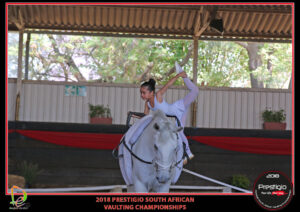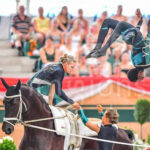A display of skill and precision.
Equestrian Vaulting is a competitive discipline where both dynamic and static gymnastic elements are combined and performed on a walking or cantering horse – gymnastics to music on the back of a moving horse. It requires outstanding physical condition from the vaulter, and a harmonious relationship with the horse is imperative if a display of strength, coordination, rhythm, suppleness and balance is to be achieved. Vaulting exercises include artistic mounts and dismounts, shoulder stands and handstands on the horse, carrying or lifting another vaulter, kneeling, standing lying, supported, sitting and hanging exercises. Judging is based on technique, form, difficulty, balance, security and consideration of the horse. Horse, lunger and vaulter are considered a competitive unit and the performance of each is reflected in the final score.
The various tests are performed on a circle that is between 15m and 17m in diameter and can take place either indoors or outdoors. Vaulting is a good entry sport for anyone wanting to start equestrian sport – it not only improves your basic seat (one of the exercises required in most of the compulsory tests) but also teaches you how to dismount safely. Vaulting is a great way to improve your confidence on, and around horses.
Types of competition...
 Individual competitions consist of a compulsory test and a free test and can be over one or two rounds. Typically Championships are held over two rounds, whereas Graded and Training shows (including SANESA) are held over one round. There is no time limit for the compulsory test but the free test must be performed within a minute. Typically and particularly at Championships, men and women compete separately. The compulsory and free test is performed at the walk or the canter – depending on the Grade. The A Grade vaulter will also perform a technical test (time limit of one minute) where the vaulter must execute 5 pre-determined moves – in any order – including other freestyle moves. The only age limit within Individual Competitions is that A Grade vaulters may only vault at this level from 16 years onwards.
Individual competitions consist of a compulsory test and a free test and can be over one or two rounds. Typically Championships are held over two rounds, whereas Graded and Training shows (including SANESA) are held over one round. There is no time limit for the compulsory test but the free test must be performed within a minute. Typically and particularly at Championships, men and women compete separately. The compulsory and free test is performed at the walk or the canter – depending on the Grade. The A Grade vaulter will also perform a technical test (time limit of one minute) where the vaulter must execute 5 pre-determined moves – in any order – including other freestyle moves. The only age limit within Individual Competitions is that A Grade vaulters may only vault at this level from 16 years onwards.
| Grade | Compulsory Test | Free Test | Technical Test |
|---|---|---|---|
| E Grade (entry level) | Walk | Walk | N/A |
| D Grade (novice) | Canter | Canter | N/A |
| C Grade (1*) | Canter | Canter | N/A |
| B Grade (2*) | Canter | Canter | N/A |
| A Grade (3*) | Canter | Canter | Canter |
 Pas-de-Deux (Pairs) competitions consist of two vaulters – who perform a free test over one or two rounds. The pas-de-deux can consist of two boys, two girls or a boy and a girl. The time limit of the free test depends on the Grade of the competition (see below). Both vaulters have to be in contact with the horse at all times – other than when they are mounting or dismounting. In South Africa – we have pas-de-deux competitions that cater for all our vaulters – from E Grade to A Grade. Like with the Individual competition – the gait of the horse depends on the Grade at which the vaulters are competing (see below). C Grade (1*) pas-de-deux also requires the vaulters to perform a compulsory test – prior to their free test. This is the only Grade in pas-de-deux that also performs a compulsory test. Both vaulters must perform the compulsory test. As with the Individual competition – there is no time limit on the compulsory test and the only age limit relates to A Grade pas-de-deux where both vaulters have to be 16 years or older. In order to compete as a Junior B Grade pas-de-deux both vaulters have to fall within the age group of Junior, from the year in which they turn 14 until the year in which they turn 18.
Pas-de-Deux (Pairs) competitions consist of two vaulters – who perform a free test over one or two rounds. The pas-de-deux can consist of two boys, two girls or a boy and a girl. The time limit of the free test depends on the Grade of the competition (see below). Both vaulters have to be in contact with the horse at all times – other than when they are mounting or dismounting. In South Africa – we have pas-de-deux competitions that cater for all our vaulters – from E Grade to A Grade. Like with the Individual competition – the gait of the horse depends on the Grade at which the vaulters are competing (see below). C Grade (1*) pas-de-deux also requires the vaulters to perform a compulsory test – prior to their free test. This is the only Grade in pas-de-deux that also performs a compulsory test. Both vaulters must perform the compulsory test. As with the Individual competition – there is no time limit on the compulsory test and the only age limit relates to A Grade pas-de-deux where both vaulters have to be 16 years or older. In order to compete as a Junior B Grade pas-de-deux both vaulters have to fall within the age group of Junior, from the year in which they turn 14 until the year in which they turn 18.
| Grade | Time | Gait | Compulsory | Free Test |
|---|---|---|---|---|
| E Grade | 1 min 30 sec | walk | no | yes |
| D Grade (walk pairs) | 1 min 30 sec | walk | no | yes |
| C Grade (1*) | 1 min 30 sec | canter | yes | yes |
| B Grade (2*) | 1 min 30 sec | canter | no | yes |
| A Grade (3*) | 2 min | canter | no | yes |

Squad competitions consist of 6 vaulters and up to 2 reserves. The squad performs a compulsory and free test over one or two rounds. Squad competition is a brilliant way to teach the young vaulters about team work and communication! This is also the only competition where the compulsory test is timed and each vaulter on the squad, including the reserves, must perform the compulsory test. Depending on how many vaulters perform the compulsory test the time limit for the compulsory test can be anything from 6 to 8 minutes (in essence one minutes for each vaulter). The free test is performed with only 6 of the vaulters and at most, 3 vaulters can be on the horse at any one time. The time limit for the squad test is 4 minutes. The gait of the test is dependent on the Grade of the Squad and Squads can be all girls; all boys or mixed. There is no age limit with Squads other than the Junior B Grade Squad – where all the vaulters on the squad have to fall within the Junior Age Category (ie from the year in which they turn 14 until the year in which they turn 18).
| Grade | Compulsory | Freestyle |
|---|---|---|
| E Grade | walk | walk |
| D Grade | canter | walk |
| C Grade | canter | canter |
| B Grade | canter | canter |
| A Grade | canter | canter |
For more information on vaulting please see the Vaulting Rules and Vaulting Guidelines.

